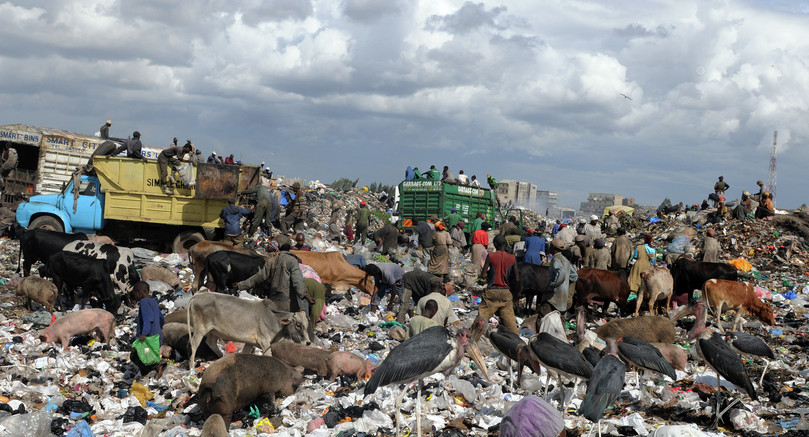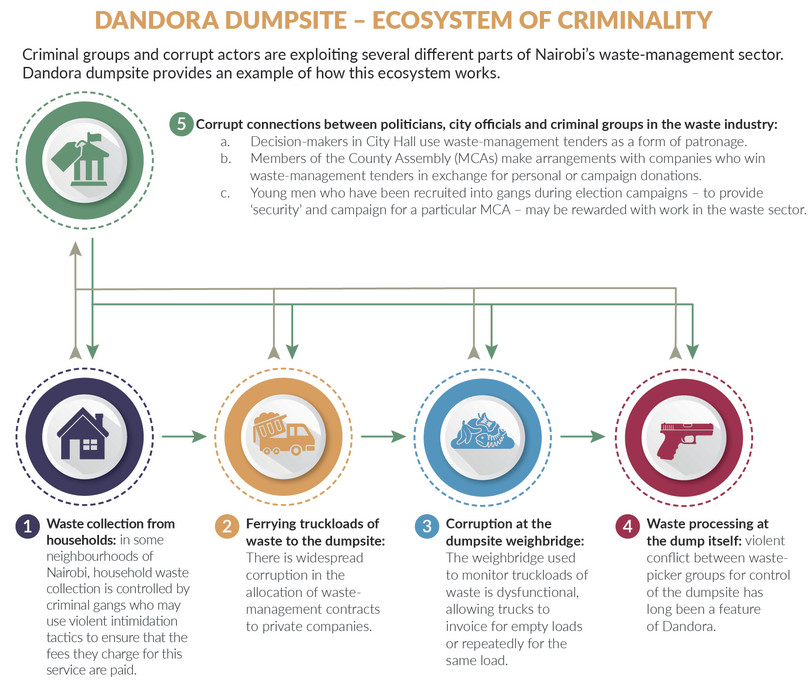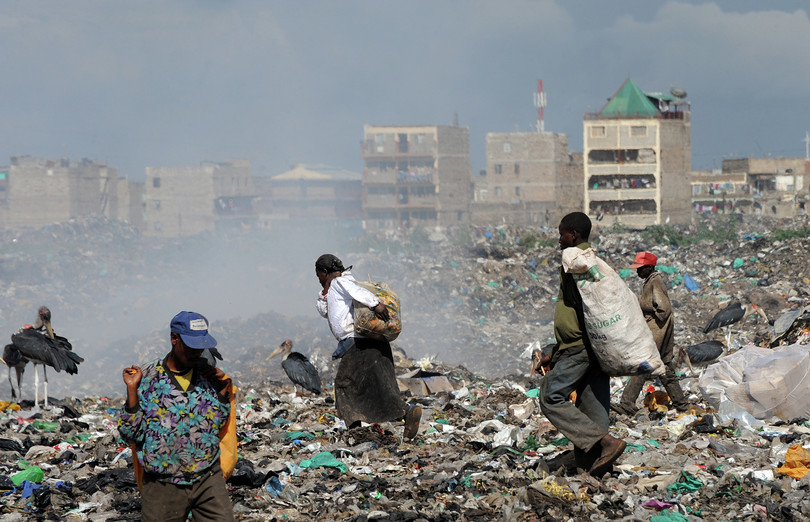Corruption and criminality at Nairobi’s main dumpsite exact a heavy toll on the city’s residents and county government.
The Dandora dumpsite, a sprawling 30-acre area in the north-east suburbs of Nairobi, is the only designated dump for the thousands of tonnes of rubbish produced daily in the city. Located in the middle of an informal settlement that is home to thousands of people, the dumpsite has long been acknowledged as a dysfunctional and highly dangerous part of Nairobi’s municipal infrastructure. Dandora has also become a hub for criminal groups and corrupt figures who operate in the city’s rubbish-collection industry.
The criminalization of Dandora follows both inter-national trends and local factors. Internationally, the waste sector is a prime target for organized crime. In August 2020, Interpol reported an alarming global increase in the illegal trade of plastic waste since 2018 and pointed to the environmental threat posed by poor (and criminal) management of the world’s waste.1 Even rich countries with strong bureaucracies are struggling to keep the waste sector free of criminal penetration. An independent review published in 2018 by the UK’s Department for Environment, Food and Rural Affairs found that ‘industrial-scale organised waste crime has emerged as an increasing problem’ in recent years.2
The waste-management sector is vulnerable to criminal exploitation because it can offer high profit margins at low risk of getting caught for involvement in illegal activities, particularly as the main regulatory agencies involved in the sector are generally not part of the criminal justice system. Furthermore, attempts to regulate hazardous materials often create a breeding ground for cutting corners and exploiting legislative loopholes. The various stages of processing waste – from collection from businesses and houses to the transport of waste and management of the dumpsites themselves – all offer opportunities for criminal rent-seeking and territorial control, and for corruption in the management of municipal contracts awarded to companies.
The complex criminal interests in Kenya’s waste sector
The Nairobi City County collects only a portion of the city’s waste itself – mostly from markets and factories3 – and hires other ministries, state companies and private collectors to do the remainder on its behalf.4 These organizations then often charge residents additional fees to collect their waste.
It is lucrative work: according to an official of the Kenyan Alliance of Resident Associations, about 900 000 households pay private collectors an average 500 Kenyan shillings (KSh), or US$4.60, per month to collect their rubbish.5 Officials in the county government say that these private levies amount to an annual turnover of KSh5.4 billion (US$45 million).6
Criminal groups and corrupt figures have become involved at several points in the waste-removal process. In some neighbourhoods of Nairobi, house-to-house rubbish collection (and the profits of the additional fee) are controlled by criminal gangs, who use violence to ensure that their services are contracted and paid for. In Kayole, in the eastern suburbs, each household pays rubbish collectors a KSh150 (US$1.35) fee. According to one member of Gaza (a gang operating in Nairobi), if this is unpaid, gangs will pour raw sewage on your doorstep or rob your compound. If you insist on refusing their services, they send people to threaten you.7
Criminals also profit when the trucks come to the dumpsite to unload waste. About 100 trucks deposit waste at Dandora dumpsite every day, many owned by the approximately 150 private-sector waste operators.8 These operators are paid per truckload delivered to Dandora dumpsite, as measured at the weighbridge.

Garbage trucks at the Dandora dump in Nairobi. This, the only officially designated dump in Nairobi, has been the site of violence between rival gangs of waste pickers and the focus of corruption related to waste-management tenders.
Photo: Simon Maina/AFP via Getty Images
However, according to interviews with a number of gang leaders, some of these trucks arrive empty but are still invoiced, while others are invoiced multiple times for a single load of rubbish. The Dandora dumpsite weighbridge is most times non-functional, yet trucks are paid for non-existent ‘clocking’ into the weighbridge.9 To ensure corruption runs smoothly, members of dumpsite-based gangs are stationed at the weighbridge to look after the interests of their patrons.10
In July 2018, a report by the auditor-general’s office revealed a number of stark irregularities in rubbish-processing contracts, including a case in which a private rubbish vehicle was weighed twice within four minutes for transporting rubbish from the city centre to Dandora – a 5.4-kilometre journey that can take up to an hour in Nairobi’s traffic jams.11 (Even clearing rubbish from the truck and cleaning it before the next trip takes longer than half an hour.) Another waste-management company was paid for working ‘29 hours a day’ based on odometer readings.
According to an official working in the Nairobi City County Revenue Department, there were cases in the auditor-general’s report where companies were paid for collecting waste from areas where they were not contracted to operate, and others where companies invoiced for work that had never been done.12
Sometimes the county government uses its own resources to collect waste in areas where tenders have already been awarded to private entities. These private entities, which are linked to county government officials, then do not have to do any work, but still get paid.13
Violence amid the waste
Groups of waste pickers work the dumpsite, reclaiming metals and other materials to sell on, but the line between an informal subsistence economy and criminal organizations is blurred. Informal waste picking is a service often undertaken by the most vulnerable and that can reclaim far more materials than formal recycling processes, but these waste-picking groups have also been implicated in violence at the dumpsite. In addition, they charge an illegal fee for entry into the dump.14
In October 2013, a youth was shot dead and his body hacked apart, doused in fuel and torched when gangs clashed in Dandora over control of the dumpsite. Police from a nearby station – who reportedly are often less well-armed than the gangs themselves – merely watched from a distance.15 That same month a gang member by the name Mulusia (alias ‘Daddy’) was stabbed to death in a turf war. During this clash, gang members exchanged fire for almost five hours as officers from the nearby Kinyago Police Station looked on, afraid of intervening in case they were robbed of their guns. Two people lost their lives in the turf war that followed.16
In 2014, the then area MP James Gakuya claimed that gangs were causing insecurity and argued that the Dandora dumpsite be relocated, forcing the High Court to direct the National Environmental Management Authority to undertake an audit of the dumpsite. But vested interests have made it impossible for the dumpsite to be relocated.
Police oversight was subsequently withdrawn from the dumpsite, which has become a no-go area for police. ‘We used to guard the place until 2016, when we were inexplicably removed from the dumpsite without reason,’ says a police officer who was once deployed at the dumpsite. ‘Now it’s an insecure area. We can only walk through the area, but we cannot risk making any arrests.’17
Interviewees report that the removal of the police presence has meant that the dumpsite has become more violent. Clashes often break out for control of rubbish, in most cases between youth from Dandora and Korogocho, two neighbouring informal settlements.18

Notes: A recent academic study into conflict and crime in the waste sector in Nairobi and Mombasa conducted a household survey with residents of Nairobi on their experiences of crime relating to waste. 45.5% of respondents reported that they were aware of cartels operating in the waste-management sector. Of these, 57.1% reported that they had themselves experienced crime and violence related to it.
Source: Kanyiva Muindi et al, Conflict and crime in municipal solid waste management: evidence from Mombasa and Nairobi, Kenya, Cities and Health, September 2020, https://doi.org/10.1080/23748834.2020.1810600.
The lack of police intervention also makes the dumpsite an attractive location for storing contraband such as guns and drugs. Interviewees told the GI-TOC that firearms are hidden in waste transported to the area because rubbish is hard to physically check and there are no scanners at the toll station. ‘You can call it [Boma Village, a settlement in Dandora dumpsite] a stock exchange for guns, if that’s the best description. The garbage isn’t screened. Police cannot hazard a swoop down on the village. We don’t know what happens there,’ says a police officer who once served at Kinyago Police Station.19 In 2018, police attempted to ransack Boma Village in search of firearms, but were repulsed in an exchange of fire with criminals.20 There have been allegations that gangs are allowed to deal guns at the dumpsite as long as they protect the interests of private waste-management companies allied to powerful people in the government.
Relationships between rubbish cartels and the political system
There is an intricate web of relationships stretching between City Hall and Dandora dumpsite, connecting politicians, private waste companies and gangs.
In interviews in January 2020, the GI-TOC was told that the waste-management tender process was used to influence members of the county assembly to ensure their support for leading political figures.21
Some assembly members make arrangements with the companies who win tenders in exchange for personal or campaign donations, and request that these companies hire certain young people to act as rubbish collectors.
These young people are typically the same men who have worked for the assembly members as ‘security’ during their election campaigns. They largely just move waste from households to a central collection point, where it is collected by trucks belonging to either the county or private companies to go to the dumpsite.22 ‘Some of the criminal groups here were started by some particular members of the county assembly who had during election campaigns promised the youths jobs. … Essentially, these are extortion groups because they demand fees from residents for the job that is really undertaken by the county government,’ says an official of a residents’ association in Buru Buru Estate, Nairobi.23
This picture of corruption is consistent with the findings of a recent study on the waste-management sector in Nairobi and Mombasa, which reported that ‘recurrent in the discussions [with respondents was the idea that] corruption within the Nairobi County Council was to blame’.24
‘Procurement in [the waste-management sector] is fraught with so many irregularities. And this has been going on decades on end, and keeps defying every change in the leadership at City Hall,’ says a veteran news reporter embedded at City Hall.25 A senior official in the Revenue Department of the Nairobi County Government highlighted the risks of challenging the status quo, saying ‘you don’t ask questions about the management and operations at the dumpsite unless you want to be eliminated’.26
The corrupt way in which waste is managed in Nairobi has sapped the county of resources to provide waste-removal services and left neighbourhoods to be extorted by criminal service providers. According to the senior official in the Revenue Department, City Hall used to collect ‘millions of shillings in revenue in a month from the dumpsite about five years ago but now all it gets is KSh50 000 [US$460] per week’.27
The fraud and lack of oversight that accompanies the criminalization of the waste-management sector is so severe that Nairobi does not even know how much rubbish it actually produces, and so how much needs to be collected. Some reports indicate Nairobi produces 2 500 tonnes of rubbish per day, while others show 3 500 tonnes. The level of procurement irregularity such as double-invoicing, and the proliferation of illegal an unofficial dumpsites – as transporters avoid Dandora due to its poor access, the dysfunctional weighbridge and the fines levied by gangs – makes exact estimates nearly impossible.28

People sort through heaps of garbage at Dandora dumpsite, Nairobi.
Photo: Simon Maina/AFP via Getty Images
An international phenomenon borne out of local political factors
The complex ecosystem of criminality and corruption seen at the Dandora dumpsite is a reflection of the systemic vulnerabilities seen in the waste sector elsewhere in the world, but it has also been driven by local factors.
Nairobi, like other cities in Kenya, has seen rapid urban growth over the past 30 years. Over that time, waste production has grown massively, while political developments paved the way for violent actors to enter the waste sector. The austerity measures of the 1990s – which resulted in the City Council (now the City County) retreating from service provision – led to the informalization of the economy of Nairobi and the entry of private actors into urban service provision and increased competition for clients and control – competition that in some instances became violent.29
This became an entrenched problem in the first decade of the new millennium as political actors offered impunity for illicit enterprises to criminal gangs who worked for them during campaign periods. The failure to deal with more ‘white collar’ forms of corruption in the city administration also allowed corrupt political actors to operate with impunity.
Gangs and other groups have, in some cases, become wealthy through providing informal services or taxing residents for transport, waste removal and electricity and water provision – services that the state has failed to provide.30 Neither is this trend likely to change in the near future: Nairobi is continuing to urbanize, but this expansion now comes at a time when waste management – an economy that is critical to the environmental and population health of the city – has become deeply criminalized.
Notes
-
INTERPOL report alerts to sharp rise in plastic waste crime, Interpol, 27 August 2020, https://www.interpol.int/en/News-and-Events/News/2020/INTERPOL-report-alerts-to-sharp-rise-in-plastic-waste-crime. ↩
-
Independent review into serious and organized crime in the waste sector, published by UK Department for Environment, Food and Rural Affairs, November 2018, https://www.gov.uk/government/publications/serious-and-organised-waste-crime-2018-review. ↩
-
Collins Omulo, Why dismantling city ‘garbage cartels’ is an uphill task, Daily Nation, 12 March 2020, https://www.nation.co.ke/counties/nairobi/dismantling-city-garbage-cartels-is-difficult/1954174-5488998-a8i8q2/index.html. ↩
-
The Nairobi City County is the successor to the City Council of Nairobi. This is a recent change in designation and references have been retrospective changed in interviews and sources referred to in this article for ease of comprehension. See https://nairobi.go.ke/about-nairobi/ for more information. ↩
-
Interview with official of the Kenya Alliance of Resident Associations (KARA), Nairobi, 18 February 2020. ↩
-
This amount is based on figures provided in interviews with City Hall officers. ↩
-
Interview with a Gaza member, Nairobi, 30 January 2020. ↩
-
Interview with a Nairobi City County official working in the Revenue Department, Nairobi, 13 June 2020. ↩
-
Interview with a leader of a gang that cleans rubbish trucks upon offloading, Nairobi, 13 June 2020; interview with a senior police officer who once secured the dumpsite, Nairobi, 14 June 2020, by phone. ↩
-
Interview with a senior police officer who once secured the dumpsite, Nairobi, 14 June 2020, by phone. ↩
-
Sh 200 million: Nairobi waste scandal: Company worked 29 hours in a day, Corruption Tracker, 8 February 2019, https://trackcorruption.org/sh-200million-nairobi-waste-scandal-company-worked-29-hours-in-a-day/. ↩
-
Interview with a Nairobi City County official working in the Revenue Department, Nairobi, 13 June 2020. ↩
-
Interview with a revenue officer with Nairobi City County deployed at Dandora, Nairobi, 12 February 2020. ↩
-
Interview with a Gaza gang member, Nairobi, 30 January 2020. ↩
-
Interview with a researcher who had done empirical research on the dumpsite, 25 October 2020. ↩
-
Interview with two gang members at the Dandora dumpsite, Nairobi, 17 February 2020. ↩
-
Interview in Nairobi, 17 February 2020. ↩
-
Youth Unemployment in Kenya – A Ticking Time-Bomb, ed. Helmut Danner et al. Nairobi: Longhorn Publishers, 2016. ↩
-
Interview with police officer, Nairobi, 18 February 2020. ↩
-
Interview with a senior police officer, Nairobi, 17 February 2020. ↩
-
Interview with an official of a neighbourhood residents’ association in Eastlands, Nairobi, 29 January 2020. ↩
-
Interview with a revenue officer at the Nairobi City County, Nairobi, 17 February 2020. ↩
-
Interview with an official of a residents’ association in Buru Buru Estate, Nairobi, 29 January 2020. ↩
-
Kanyiva Muindi et al., Conflict and Crime in municipal solid waste management: evidence from Mombasa and Nairobi, Kenya, Cities & Health, https://doi.org/10.1080/23748834.2020.1810600. ↩
-
Interview with reporter, 14 June 2020, by phone. ↩
-
Interview with a revenue officer at the Nairobi City County, deployed at Dandora, Nairobi, 12 February 2020. ↩
-
Ibid. ↩
-
Interview with a Nairobi City County official working in the Revenue Department, Nairobi, 13 June 2020. ↩
-
Kanyiva Muindi et al., Conflict and Crime in municipal solid waste management: evidence from Mombasa and Nairobi, Kenya, Cities & Health, https://doi.org/10.1080/23748834.2020.1810600. ↩
-
Ken Opala and Simone Haysom, The Politics of Crime: Kenya’s gang phenomenon, Global Initiative Against Transnational Organized Crime, November 2020, https://globalinitiative.net/analysis/gangs/. ↩
